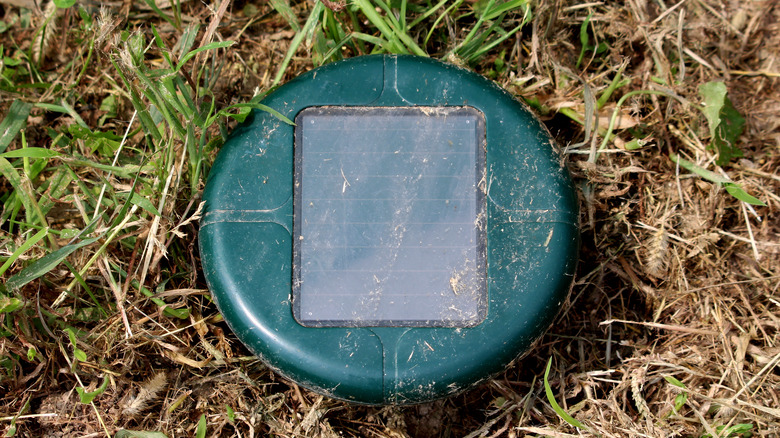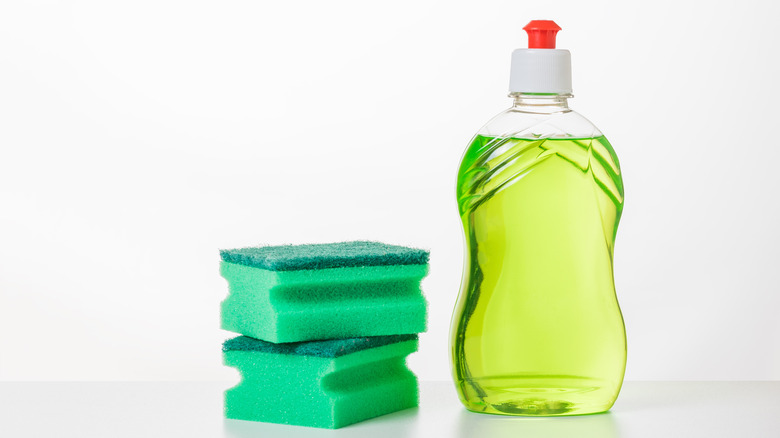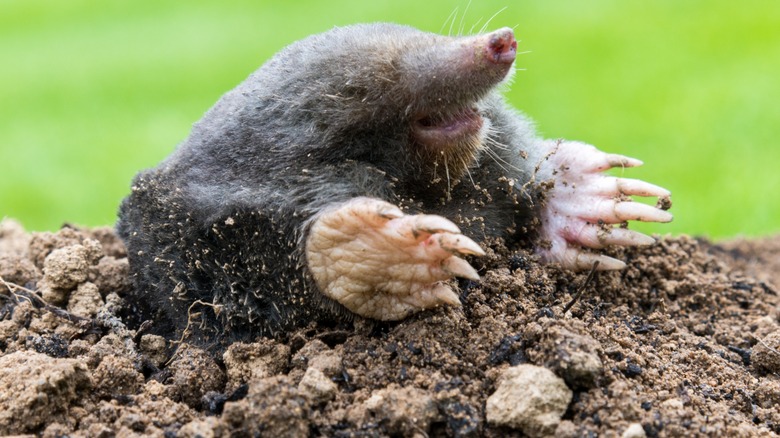Ever heard the saying do not make a mountain out of a molehill? Well, when it comes to actual molehills, it is worth the mountain of fuss. The experts at Westchester Wildlife write that moles can cause a litany of damage to your yard. First on the list is that the tunnels created by moles provides room for other underground pests to wreak havoc. That’s not to mention possible erosion, or even tripping over the molehill yourself.
The good news is that there are several ways to get rid of the moles in your garden or yard. The bad news, however, is that some of the most effective strategies might be difficult to apply. This is why we spoke about preventing the hidden dangers that are ruining your garden much earlier.
Not to worry — if you are all repulsed by the idea of dealing with moles or worried about the time and energy it’ll take from you, you can always call pest control to do their thing while you sip some cola on the porch. But if you’re ready to tackle this task yourself, read on.
Set mole traps

Your go-to mole trap should be a one-way trap, often a carton with just one opening which you’ll place out in the yard, very close to the active molehill. So get this: place bait in the trap, leave it open, and sit on the porch. As soon as you notice a disturbance in your one-way trap, slam it shut (unless it does so automatically) and go release the mole far away from your home. Almanac says releasing moles 5 miles away will keep those critters out for good.
Amazing, isn’t it? Well, it is not that easy; there are a couple of steps to take before deciding to use a mole trap on the pesky underground mammals troubling your lawn. For one, using traps works best in an active hole. To determine whether or not a hole is active all you have to do is to cover up one of the little mountains, and if by the next day it is open again, bingo! You have an active hole.
There are also traps that can be used once that do not require monitoring. However, this could kill moles, so you first have to check in with the local authorities; Pest Control Products says to ensure that you are legally allowed to use these kinds of mole traps in your specific region.
Eliminate mole food sources

Another tactic you can use to get rid of moles is to simply ensure that they have no food in your landscape, lawn, or garden. Even humans will die from lack of food or relocate, as our ancestors always did; even now, people migrate for greener pastures. What makes you think moles are any different? However, while this may sound like your messiah plan, it’s not all that easy. Here’s the deal: You might not see results for a while because, in essence, this method is a means to an end.
The main meals for moles are grubs, earthworms, crickets, ants, and insects. To rid them from your yard, use items that are essentially made and procured for pest control only. This is because you want to ensure that you do not damage your plants and lush grass in the process.
As soon as you are done with eliminating their meals, the moles will be on their way to finding a new home. You can consider doing this routinely to consistently make your landscape inhospitable for those pesky pests, says Home Depot.
Use plants strategically

Inna Sen/Shutterstock
We have always thought there is a fix for everything in nature and quite frankly, we keep finding reasons to believe that. To that end, Smith’s Pest Management writes that moles heavily dislike certain scents of flowers — mostly the Allium flowers, like daffodils and marigolds.
If you just recently got rid of a mole problem or you’re trying to prevent one, growing daffodils and marigolds in your garden is an excellent idea. If growing these flowers from scratch is too stressful you can always just repot blossoms you buy from the store using the instructions stated in our guide to marigolds. This is an amazing addition to your garden and you’re killing two birds with one stone, too.
On the flip side, the plants will require ongoing maintenance and care. If you do not think that you can provide the needed care for these flowers on a long-term basis, keep reading on. You’ll surely find a tip that works perfectly for you.
Dig a trench

Ilia Baksheev/Shutterstock
It’s time to play beaver. Wait, no, beavers build dams not trenches, but you get the idea! A very practical way to get rid of moles and further prevent them from ravaging your lawn is to create a barrier; dig deep, up to 10 feet into the ground. Cardinal Lawns says you can always do this to separate your garden from your yard. This way, if you have a mole infestation in your yard, they’ll most likely not invade your garden as well.
For best results, Garden Seeker says that you should fill the trench with pebbles and little stones before putting the dirt back in. This way, the moles will not be able to do their tunneling past the barrier. Another great technique is to use gopher wires or baskets to form barriers and control mole invasion. This method was recommended by the experts at Smiths Pest Management. Finally, you do not have to use this technique for garden/lawn separation alone; you can always do so at the edges of your property.
Use mole repellent

Hecos/Shutterstock
Moles cannot stand a plethora of smells. To that end, the active ingredients in mole repellent are the bane of those furry animals that have a penchant for crisscrossing and ruining your amazing lawn. Tom Cat recommends a couple of their mole repellent products and suggests that for maximum efficiency, they should be applied monthly while the invasion is still very active. Even after the moles are gone, use these products for up to six months to prevent a re-invasion.
However, if you are rather conscious or concerned about the effects that mole repellent will have on the fertility of your soil and even pre-existing plants, you can always get rid of moles via the way grandma used to. We have all of the recipes.
InquirerNet recommends using castor oil (among other ingredients) because its properties are lethal to the moles; it’s either they vacate the premises or they die. Other home ingredients you can employ to boot these furry friends out of your yard include apple cider and even aloe vera.
Set up a sonic spike

FotoHelin/Shutterstock
Got moles? They are common backyard visitors that burrow themselves into the ground and can become quite a nuisance to homeowners. According to Georgia Wildlife Resource Division, depending on the species of mole, the burrows they create can be surface level (temporary burrows) or deeper ones ranging from 6 to 23 inches below the surface (permanent burrows). How can you possibly find every burrow without digging up the entire yard?
A tactic you could explore to rid your yard of moles safely is using a sonic spike (via Walmart). You can find these devices in any local hardware, garden, or home store and on the internet. After being inserted into the ground, these spikes go to work by emitting a pulse using solar energy that annoys moles and deters them from staying in the area (via Alford Wildlife & Pest Management). This technique is simple to self-install at home and relatively cost-efficient. Additionally, this method is a poison-free alternative to removing moles from your property once and for all. However, the benefit of humans not being able to hear the pitch from the device is not extended to furry friends. It’s possible cats and dogs may be equally as irritated by the pulses as the moles.
Mow the lawn more often

Tchara/Shutterstock
If you have a small mole infestation or you’re simply trying to prevent one from happening, go on and ask yourself a simple question: How often do you mow your lawn? The answer could likely determine if moles will lurk around your property undetected by you. Without proper maintenance, grass can grow exceptionally tall, concealing any critters and their habitats. Overgrown grass is a perfect camouflage for a mole. You can safely prevent them from making a home on your property by maintaining how often you cut your yard and how tall you keep the turf.
According to Lawn Pride, since moles use tall grass as a natural cloak from predators, the shorter your yard is, the better. Keeping the grass around your home under 4 inches prevents moles and other pests from concealing themselves (via Davey). A backyard that is well cared for allows you to notice any movement or new burrows shaping above ground. Mole burrows will look like cone-shaped mounds of dirt about 2 inches in diameter, according to Terminix. This maintenance technique can be most effective combined with other removal solutions and when dealing with about one or two moles. Trim the yard regularly for the best chances of maintaining a no-mole sanctuary.
Use vinegar as a natural deterrent

ThamKC/Shutterstock
Moles can be pests as their tunnels drudge up lawns and wreak havoc underground. Luckily, there are natural ways to get rid of them, which will not harm any pets, humans, or vegetation that may share the space with your temporary visitors. An effective solution to help resolve that pesky mole issue is right inside your pantry: vinegar.
According to Backyard Boss, a recommended homemade mixture of 1 part vinegar and 3 parts water in a spray bottle is a possible all-natural solution to ward off moles in your yard. Its effectiveness lies in how strong of a scent the mixture transmits. The stronger, the better, as the burrowers prefer less pungent smells. There are two types of vinegar to consider when making the concoction at home: white vinegar and apple cider vinegar. As per Lawn Holic, the differences in the acidity of both kinds of vinegar will determine its success. For the best mole-eliminating results, apple cider vinegar is ideal as the latter doesn’t produce as strong of an odor. Ultimately work with what you have and reapply the mixture as needed around the areas the moles frequent most.
Blend together dish soap and castor oil

Vladimir VK/Shutterstock
Get rid of the mole problem outside your house by focusing on what we already know about the species. While you can trap moles in cages and dispose of them in more forceful manners, there are plenty of humanitarian options still left to explore. We already shared an all-natural home solution as a possible repellent, but we have another suggestion that may be more suitable. As you know, moles do not like overpowering smells around their burrows. If you tried the homemade mixture of vinegar and water and the results were unsuccessful (or your pantry really didn’t have either type of vinegar), consider making another natural remedy that is people and pet friendly.
According to Crafty Little Gnome, you can create a mole repellent using dish soap, some water (optional), and castor oil. You can locate any castor oil or dish soap brand in most local grocery or beauty supply stores. It is recommended to combine the ingredients well and disperse the contents around the burrows and on the actual molehills. The mixture will irritate the moles’ skin and stomach if digested (it helps that they don’t like the taste), but it shouldn’t cause lingering harmful reactions for the animal. The effects of smell and irritation should relocate the moles away from your home without harm. For any moles that return or don’t seem to get the hint, continue applying the mixture on the property until you see noticeable results.
Try to use coffee grounds

Thijs de Graaf/Shutterstock
What is that smell? It’s not vinegar or castor oil but coffee. Just when you thought we were out of all-natural remedies, we are here with another possibility for you to rid that lawn of moles! Staying on theme with scenting the yard with smells moles don’t like, consider combining coffee grounds and water or simply scattering the grounds (and even the beans) around the affected areas most visited by the ground dwellers. Mix any coffee beans that you have available and use them as an organic mole repellent, as per OutdoorAlive. Liberally distribute the coffee creation and allow it to sit overnight for best results. It does not matter if the coffee is brewed or not brewed.
However, keep in mind that coffee grounds could be harmful to the surrounding foliage. According to Discovery, coffee is naturally highly acidic, making it great for some flowers and fruits but highly damaging to others. If you are concerned about any flowers or garden beds in your yard, be mindful of where the solution is being applied or seek alternative measures for these locations that aren’t as harmful to the greenery. Using beans without the liquid component may be best to prevent accidentally spraying the plants. No harmful effects occur in moles other than their distaste for the scent and taste.
In-ground windmills

Sergei Dvornikov/Shutterstock
No one likes to find a molehill in their yard. Moles have an unruly habit of ruining gardens or gorgeous green grasses. When you find one (or more) in your own lawn, you could be left wondering how to dispose of moles without harming them and further destroying your backyard or front yard. This subsequent treatment has nothing to do with smell but does have to do with sound.
Much like how moles don’t like certain smells, they don’t like certain noises either. For a harmless way to clear out moles from their burrows, consider installing a mole-chasing windmill on your lawn. According to Lehman’s Hardware Store, the wind-spun blades create a vibration that agitates the moles underground, ultimately causing them to move out due to disturbance. The windmills are an effective tool to ward off moles for up to 75 feet in all directions. This approach has minimal upkeep, and it doesn’t require reapplication for effective results.
Bait with poison as a last resort

Africa Studio/Shutterstock
Now, this is not our favorite method, but some moles can be sneaky so much that this becomes the only way to get rid of them. The last tip we have for you is to use good old-fashioned bait; you can either take this hook, line, and sinker (pun intended), or take it with a pinch of salt (another horrible attempt at a pun). The bottom line is that there are two basic ways to set a mole trap with bait: one will/can kill the mole, or the other, which will allow you to catch and release moles somewhere else. If the latter doesn’t work, the former is useful as a last resort.
The mole bait can either be actual live bugs and grubs or a dummy, says MedicineNet. All you have to do is to infuse them with poison and place them in the hole or at the edge of the hole. Then, whenever the moles come by to have a bite, you know you’ve won. The moles are taken care of, and your yard is safe.




